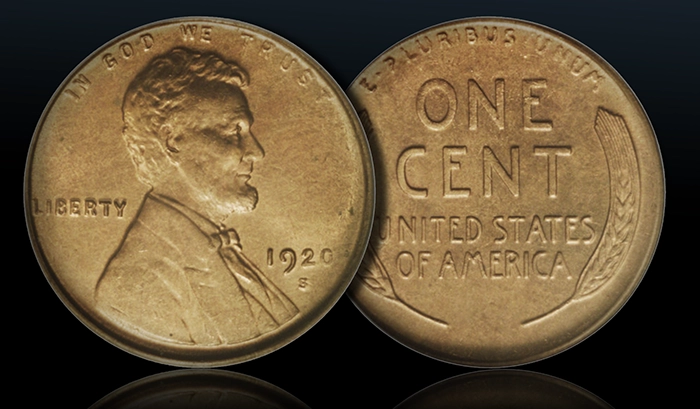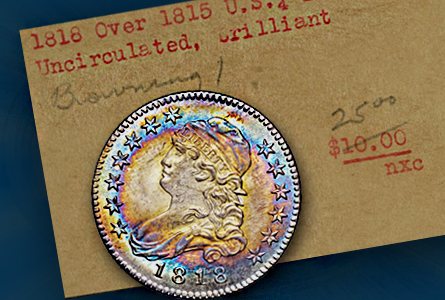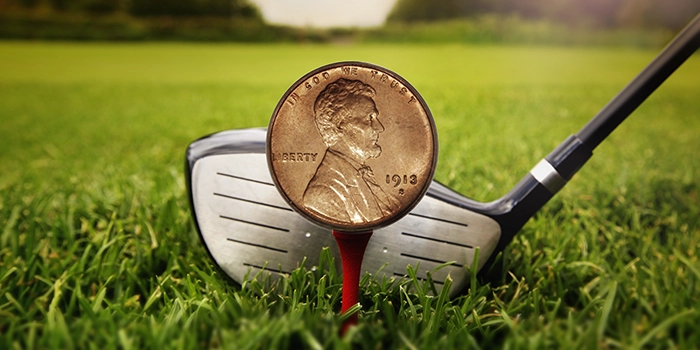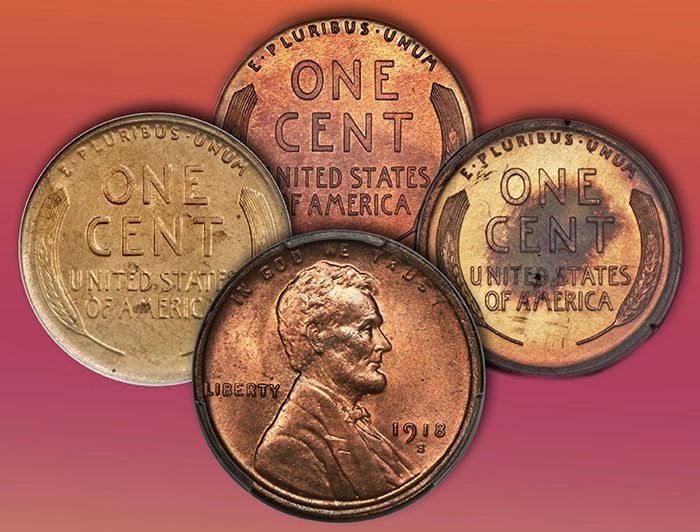By Charles Morgan for CoinWeek …..
Although there have been several significant Lincoln cent collections assembled and disassembled over the last few decades, two collections represented the height of the marketplace for the series.
The first was the Joshua and Ally Walsh Collection. The January 2006 Heritage Auctions sale of this collection set many records, but the prices were not sustained. By 2008, several coins from the sale had realized significant declines.

Famous silver dollar collector Jack Lee was a prominent purchaser of the Walsh coins, buying into the series at the peak of the market. After he died on August 17, 2008, the Lee estate consigned his cent holdings to Heritage, where they saw appreciable losses across the board. One of many examples of this is the Walsh-Lee 1920-S cent. The coin realized $48,875 USD in the Walsh sale, only to go for $34,500 in the Lee sale. This happened repeatedly with Lee’s set, and the declines for many dates and mintmarks persisted over the next 15 years.
The second was the Stewart Blay Red Copper Collection, which was sold by GreatCollections on January 15, 2023.
Blay was a New York-based sculptor who traveled the country for over 50 years on a quest to assemble a collection of the finest cents. He consigned it to GreatCollections in 2022 but unfortunately passed away before the record $7.7 million sale.

Given the overlap in time of these two great sets, the Walshes, Lee, and Blay must have been competing against each other (in many instances, at least) for the very best coins. Judging the three collections side-by-side, it’s clear that Blay had the upper hand.
And while the Walsh set was top-tier for its time, one wonders if collectors in the 2006 market truly understood either the quality of the coins that Blay held in his collection at the time or the quality of the coins that had yet to appear on the market in third-party holders with the correct grade.
What we do know is that the “honeymoon” period for the Walsh coins was short-lived, and if history is any indicator, then a similar outcome may await the upper-end Lincoln cents of the Blay Collection – and for top-tier Lincoln Wheat cents in general.
Quick Flips Hurt High-End Coins
Buying top-of-the-line coins from historic collections makes sense if one needs the coins to pursue their own collecting goals. “Historic” collections are so-called due to the personality of their collectors and the sum of their component parts. This was true for the Gardner, Pogue, Simpson, and Newman collections and it is also true for the Stewart Blay Lincoln cents.

Furthermore, historic sales stir up massive collector enthusiasm as they mark the completion of what are often lifelong pursuits. For many prized coins, these sales are the first chance that many active collectors have to buy specific coins. The window to acquire the best coins is typically open only for so long–this is one of the reasons that collectors “overpay”.
Those buying into the enthusiasm of a sale in the hopes of profiting from a quick turnaround are often disappointed to learn that significant arbitrage is lost by the quick flip. A survey of the aforementioned Pogue, Simpson, Newman, and Gardner collections shows a softer resale market for the material in the first few years following the initial sale. A major reason why pedigreed coins are re-certified with the pedigrees removed is to obfuscate their sale of origin. One wouldn’t do that unless they felt that transparent markets hurt their ability to resell coins in the short term.
So how will the Blay coins impact upper-end material in the future? What will Blay coins bring when they return to the market? We will find out soon enough.
A Steady Stream of New Coins Dragged Down the Market
But the biggest factor leading to the decline of upper-end Wheat cent prices over the past 20 years has been exploding populations of high-grade coins. Collectors in 2006 had no idea that the 1913-S Lincoln cent that realized $63,250 would lose 20% of its value by 2008 and 50% of its 2006 price by 2023 due to the doubling of the certified population at MS66RD. It’s also no longer considered the finest of the issue; an MS66+RD was made in 2019.

This gets to the core of speculating in condition census coins: it’s impossible to predict what future population levels will be in the medium-to-long term. An untold number of collectors and dealers have been impacted by this issue since the advent of commercial third-party grading over 35 years ago. Even executives at major grading services have groused about it over the years.
Yes, resubmissions and upgrades have a real impact on the population data and the market’s perception of value, but this isn’t the only reason for the irruptions. Simply put, there are many more nice coins out there than anyone had any expectation of finding. The profit motive has brought many of these out of the shadows, and will continue to do so for the foreseeable future.
Your Experience May Vary
Another consideration is the physical nature of copper and its propensity to mellow, turn color, and rot inside (and outside) of a coin holder. This is especially acute when it comes to Lincoln Wheat cents and it plagues many of the coins in the condition census.
The quality of an issue’s strike, the vibrancy of its red color, and the overall eye appeal are not consistent. In this respect, a collector like Stewart Blay may have rejected scores of supposedly high-end coins in favor of the ones in his set. A less-informed buyer may not have the same degree of expertise to do so.

The grading system that is currently in place is not sufficient to communicate the true character of copper coins. The “Red” (RD) and “Red Brown” (RB) attributions are a problem since they don’t strictly take into account the mellowing of the copper color. Furthermore, the market misunderstands quality and fails to account for amazing RD and BN coins with eye-popping color, just as there are hideously ugly coins in high grades that are called RD by the grading services.
The set registry bias in favor of RD undervalues Premium Quality coins that have unique and distinct characteristics and overemphasizes “ugly” coins because of the grade stamped onto the label.
Strike quality and mintmark punch quality are also key issues. Wheat cents struck from early dies look appreciably better than coins with blurry letters and globulous Lincolns. There are also many high-end Denver and San Francisco coins with sloppy mintmarks or mintmarks that are barely visible. Within the highest grades, these factors dog the series and we all know that coins with low eye appeal are a drag on the market.
On Third-Party Grading Services
In the spirit of full disclosure, understand that CAC, NGC, and PCGS all support CoinWeek through advertising and have collaborated with us on a number of projects throughout the years. We also feel that all three companies provide a valuable service for collectors and are central to our numismatic community.

Having said that, the absence of NGC coins at the top end of the market is obvious and somewhat surprising. For example, our survey of recent auction data for MS65RD or better 1916-S cents is heavily skewed in favor of PCGS. To our knowledge, the sole NGC MS66RD coin has not appeared at a Heritage, Stack’s Bowers, or GreatCollections auction. Both services report three 1911-D Wheat cents in MS67RD. The most recent sale for an NGC coin was a February 2023 auction, where a specimen with a weak mintmark brought $16,800. The Jack Lee-Bender Family PCGS MS67RD that sold a few months earlier brought $66,000 (interestingly, this is an example of a coin that has been upgraded one full point since the 2008 Lee sale).
This comparison may, however, be a mismatch, as the Lee-Bender coin looks significantly nicer, and $16,800 is twice as much as recent PCGS MS66+RDs are bringing at auction.
This same story of under-representation or price mismatching is repeated across multiple dates.
We’d love to see more NGC material at this upper level to form a real opinion on the matter, but so far, the evidence is scant.
As for CAC, the company is projected to enter into direct competition with both PCGS and NGC this summer. If CAC succeeds in its transition from a third-party grade verification service to a third-party grading service, then there will likely be a major disruption to the status quo. In that event, the population census issue that we discussed earlier will become even more of a conundrum for the market.
It’s worth noting that many top-pop Lincoln Wheat cents are not CAC-approved or were not CAC-approved when brought to auction. What will the CAC standards be and we will start to see a cross from PCGS to CAC of the better coins?
One thing is for sure, the Walsh and Blay sets were sold at precisely the right time.
* * *





Why is. I c g never mentioned all that group used to work for anacs or ngc or pcgs
Hi Ralph,
My decision to not include ICG is based on their position in the market and not the expertise of their people or their work history.
Very thought provoking article Charles! As an early copper enthusiast it always tickles me when one considers the rarity and price structure of a 1909-S VDB; the “low” mintage exceeds the entire YEAR for many earlies! And as a counterfeit researcher the number of fakes of that variety is staggering. Not a collector of this series I have a great seat to watch as the future unfurls for these in the market…
Very Unique!!! I may have a few wheat pennies
myself!!
This message is for any one who May have knowledge of where or who I can send my coins to and have them looked at for their value.alao I have a 5 dollar bill that looks like the ink on the front side is very noticeable to the necked eye.i really appreciate it if I can get a little bit of help with this process I have never done it before.thank you in advance. Forgive me for not introducing myself first ,. My name is Patrick Gray. Thanks